Cyathus striatus (Huds.) Pers. - Fluted Bird's Nest
Phylum: Basidiomycota - Class: Agaricomycetes - Order: Agaricales - Family: Agaricaceae
Distribution - Taxonomic History - Etymology - Culinary Notes - Identification - Reference Sources
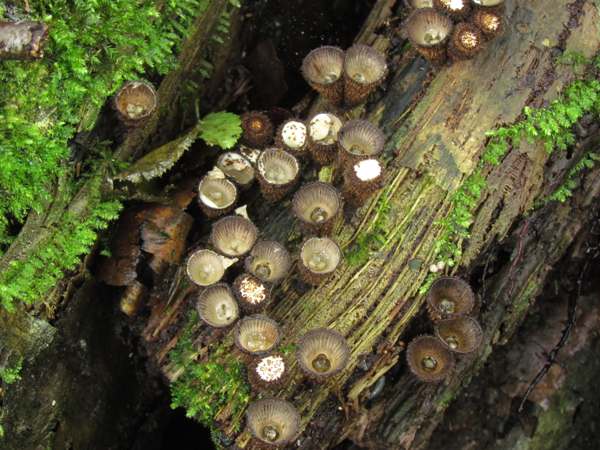
Commonly known as the Fluted Bird's Nest, this saprobic fungus is widely distributed throughout temperate parts of the world - so much so that you might wonder why so few people have ever seen it... until you see these tiny brown fungi on a rotten brown log. They blend in so well with their background that overlooking them is the norm rather than the exception.
This basidiomycetous fungus really does look like a tiny bird's nest containing several minute eggs.
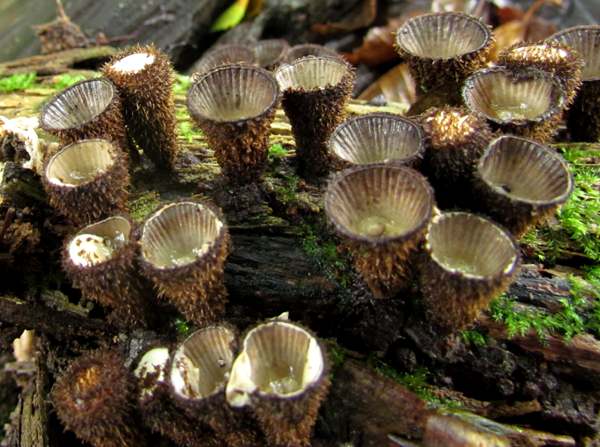
At the base of a conical structure known as a peridium, the 'eggs' are lens-shaped structures known as peridioles, and the inner surface of the walls of each peridium are lined with basidia upon which the spores develop. What makes Cyathus striatus immediately recognisable are the flutes, or striations, on the inside surfaces of its conical cups. Also distinctive is the hairy exterior of the peridium - pictured above.
The appearance of this gasteromycete varies a lot. Some are a bright orange-brown while others are dark grey or a very dull brown. Typical peridia are about 1cm wide at the top of the 'nest' and up to 1.5cm tall. Harder to spot are those barely half as wide and well under 1cm in height. Something that can help you spot these gregarious little fungi are the lids, known as epiphragms, that cover young fruitbodies and prevent rain entering until the eggs (peridioles) are ripe; the epiphragms are white, initially covered with brown hairs that later fall off.
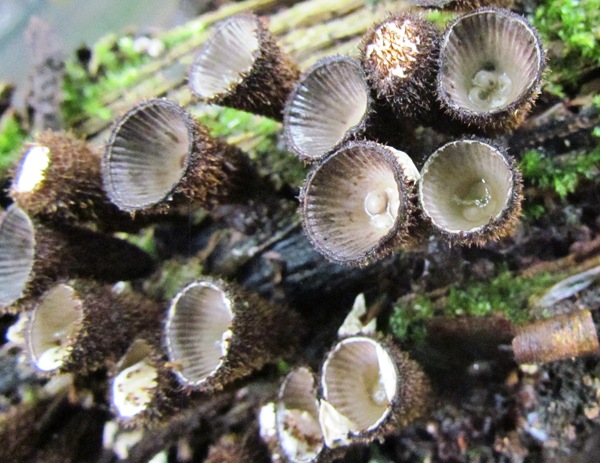
The spore dispersal process of the bird's nest fungi is fascinating. When raindrops slide down the sloping sides of the cup they can dislodge the peridioles and eject them from the cup. Each peridium is connected to the inner surface of the cup by a funiculus, which is a hollow tube or sheath around a coiled up length of inter-woven hyphal cord. When the peridiole is ejected from the nest the funicular sheath ruptures, so that the peridiole carries behind it a long fine funicular cord attached to a sticky mass of hyphal threads known as a hapteron. Before the peridiole hits the ground, the hapteron may collide with a twig so that the funicular cord becomes wrapped around the twig, causing the peridiole to rotate around the twig until its cord is fully wound up. By this ingenious means the spore-filled peridiole is brought into contact with a potential food source for a new mycelium. (For this fungal species to reproduce, two compatible mycelia must make contact; this 'mating' can then result in a new colony of fruitbodies. Only a tiny minority of spores ever get to reproduce sexually.) This game of 'tiddlywinks' can result in peridioles landing several cm away from their parent cup, but as the walls of the peridiole break down so the spores within it are washed further away by rain, and as a result a lot more woody debris can become infected with the mycelium of Cyathus striatus.
There is yet another way in which spores can be dispersed: small animals sometimes eat the spore-filled peridioles, and after passing through the gut of an animal the spores are still viable, so that wherever they are deposited it is possible for a new mycelium to begin growing.
In a small copse of mixed broadleaf trees, Fluted Birds's Nest fungi were found swarming over a long-dead tree trunk, possibly of a Hornbeam (pictured below). Although several other fallen trunks lay in the same small area of woodland there was no evidence of Cyathus striatus fruitbodies on any of them. Maybe in future years they too will become food for this remarkable fungus, which seems to prefer timber that has already been attacked by other saprobic fungi.
Returning to the same spot a year later, the Fluted Bird's Nest fungi were still munching on the same log and apparently had not spread to any others.
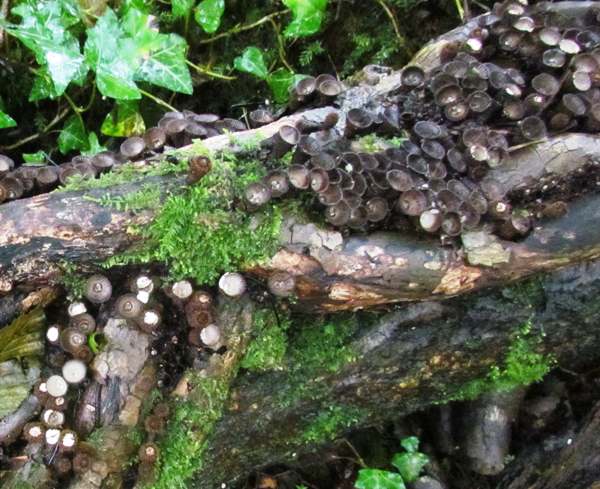
Distribution
Probably fairly common and widespread throughout Britain and Ireland but rarely reported because they are so small and inconspicuous and because their habitat is dark, damp woodland, Fluted Bird's Nest fungi are found also throughout other temperate parts of the world including mainland Europe and Asia. This species is known to occur in many parts of North America.
Taxonomic history
The Fluted Bird's Nest was described in 1778 by British mycologist William Hudson (1730 - 1793), who called it Peziza striata (effectively placing it within a group of ascomycete cup fungi, whereas this and the various other bird's nest fungi are, of course, basidiomycete species). It was Christiaan Hendrik Persoon who, in 1801, transferred this species to the genus Cyathus, creating its current scientific name Cyathus striatus.
Synonyms of Cyathus striatus include Peziza striata Huds., Nidularia striata (Huds.) With., and Cyathella striata (Huds.) Brot.
Etymology
The generic name Cyathus comes from the Greek prefix kyath- meaning cup shaped (like a chalice). Even more obvious is the meaning of the specific epithet striatus, which refers to the striate or striped (ribbed) sides of the cups of these remarkable little fungi.
Identification guide
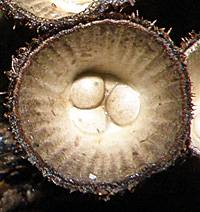 |
FruitbodyFunnel-shaped fruitbodies form initially as light-brown fluffy inverted cones on decayed hardwood or on woody debris such as wood-chip mulch; they become darker with age, and the pale lid falls away (usually collapsing inside the 'nest') to reveal the egg-like peridioles. Each peridium or 'nest' contains typically four or five silvery flattened 'eggs.' While the outside of a peridium is covered with fine grey-brown to orange-brown hairs; the inner surface hairless but fluted (striated) vertically - referred to in both the common name and the specific epithet. Peridia are 6 to 10mm across and 6 to 15mm tall, with a steady taper outwards towards the rim. The individual peridioles are typically 1 to 2mm across. |
 |
On the left is pictured a peridiole with its attached funicular cord connecting it to the inner wall of the peridium (nest). The peridiole shown here is dark olive-grey, but the colour can vary from almost pure white through various shades of brown to almost black. |
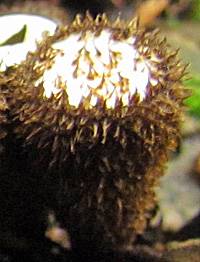 |
EpiphragmThe lid, known as an epiphragm, that covers young fruitbodies and prevents rain entering until the eggs (peridioles) are ripe, is white, initially covered with brown hairs that later fall off. Often it is the glint of an epiphragm that betrays the presence of these well-camouflaged fungi to a casual passer by. StemThe base of the cup tapers inwards to form a rudimentary stem. |
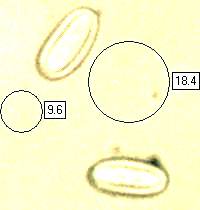 |
SporesEllipsoidal, smooth; continuing to expand after detaching from basidia; 15-20 x 8-11 µm; inamyloid; hyaline. Spore massWhite. BasidiaThe basidia are usually 4-spored. |
Odour/taste |
Not significant. |
Habitat & Ecological role |
This saprobic fungus is most often found in clusters on dead wood - particularly softwood - in open forests and on woodland edges, but Cyathus striatus also grows on wood chip that has been used as a mulch in parks and gardens. Well-rotted damp timber is the staple diet of the Fluted Bird's Nest fungus, whose fruitbodies can be seen from early summer through to the onset of winter. |
Season |
May to November in Britain and Ireland, but fruitbodies sometimes persist well into the New Year. |
Similar species |
Cyathus stercoreus is very similar (its rim is not so widely flared, however) but its peridioles are much smaller; it is a dung-loving species (the specific epithet stercoreus means 'filth') but is also found on marram grass in coastal sand dunes. Several similar species occur throughout Europe. Cyathus olla (without ribbed nest walls) and Crucibulum laeve are fairly common (but equally hard to spot) in Britain and Ireland as well as on mainland Europe and further afield. |
Culinary Notes
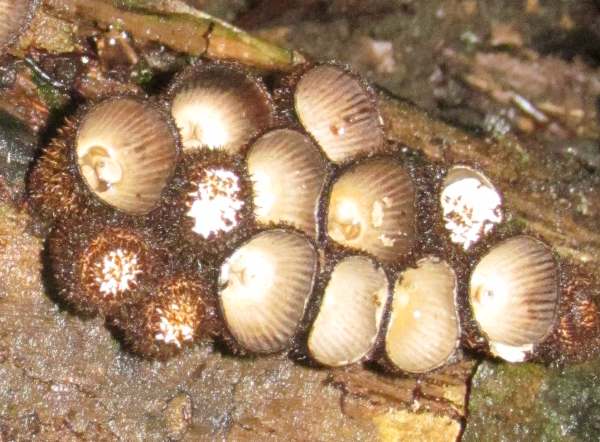
All kinds of bird's nest fungi, including Cyathus striatus, are reported to be inedible. My research has revealed no recipes for cooking these kinds of eggs, and the Fluted Bird's Nest is not an ingredient of any kind of bird's nest soup... at least as far as I know!
Reference Sources
Fascinated by Fungi, 2nd Edition, Pat O'Reilly 2016, reprinted by Coch-y-bonddu Books in 2022.
Dictionary of the Fungi; Paul M. Kirk, Paul F. Cannon, David W. Minter and J. A. Stalpers; CABI, 2008
Taxonomic history and synonym information on these pages is drawn from many sources but in particular from the British Mycological Society's GB Checklist of Fungi.
Fascinated by Fungi. Back by popular demand, Pat O'Reilly's best-selling 450-page hardback book is available now. The latest second edition was republished with a sparkling new cover design in September 2022 by Coch-y-Bonddu Books. Full details and copies are available from the publisher's online bookshop...

